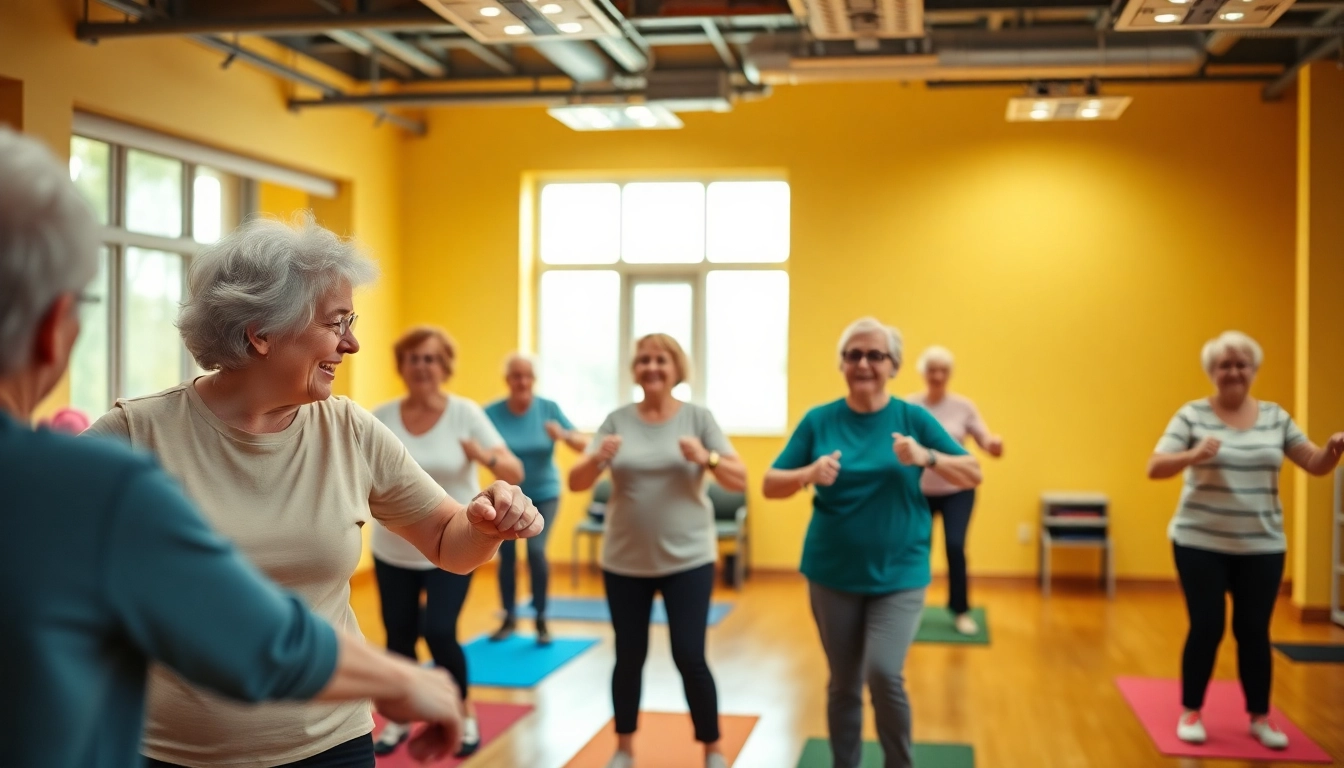Understanding Senior Fitness Training
As individuals age, the need for physical activity becomes increasingly vital. Senior fitness training plays a crucial role in promoting health, independence, and overall quality of life for older adults. It encompasses a variety of exercises tailored to meet the unique physiological needs of seniors. With programs focusing on strength, balance, and flexibility, senior fitness training aims to enhance functional movements and prevent injuries. Whether you’re beginning your fitness journey or looking to improve your current routine, Senior Fitness Training offers insightful paths to elder well-being.
What is Senior Fitness Training?
Senior fitness training refers to physical activity programs specifically designed for older adults. This demographic often faces different physiological needs due to aging, such as reduced muscle strength, decreased bone density, and challenges with coordination and balance. The training programs may involve a combination of aerobic, strength, balance, and flexibility exercises. Each program must consider individual health conditions and goals, making personalized programs essential.
Benefits of Regular Exercise for Seniors
Engaging in regular exercise has myriad benefits for seniors, which include:
- Improved Physical Health: Regular workouts enhance cardiovascular fitness, muscle strength, and joint flexibility, contributing to overall health.
- Enhanced Mental Well-being: Studies show that physical activity reduces symptoms of anxiety and depression, improving overall mood and cognitive function.
- Social Interaction: Group exercises and classes provide social engagement, combating feelings of loneliness and isolation often experienced in older adults.
- Increase in Longevity: A consistent exercise regimen can contribute to a longer, healthier life by mitigating risks associated with chronic diseases.
- Fall Prevention: Regular strength and balance training significantly reduces the risk of falls, a major concern for seniors.
Common Myths About Senior Fitness
Despite the known benefits of exercise, several myths persist regarding senior fitness:
- Myth 1: Exercise is dangerous for older adults.
Fact: While some caution is necessary, tailored exercise significantly reduces injury risks and promotes safety. - Myth 2: Seniors should avoid weight training.
Fact: Strength training is crucial for maintaining muscle mass and increasing bone density. - Myth 3: Exercise is only for fit people.
Fact: Anyone can start exercising regardless of fitness level; adapted activities can be beneficial. - Myth 4: All seniors need the same fitness regimen.
Fact: Individual needs vary; personalized assessments for fitness are crucial.
Key Components of Effective Senior Fitness Training
Aerobic Exercises for Senior Health
Aerobic exercises are essential for enhancing cardiovascular health, increasing stamina, and promoting overall well-being. Popular aerobic exercises suitable for seniors include:
- Walking: A simple and accessible form of exercise that can be tailored to individual fitness levels.
- Swimming: Provides a low-impact workout, reducing strain on joints while providing full-body conditioning.
- Cycling: Both stationary and outdoor cycling can improve cardiovascular fitness without heavy stress on the joints.
- Dancing: Engaging and social, dancing improves coordination and benefits mental health.
- Water Aerobics: Offers adjusted resistance due to water’s properties, making it perfect for enhancing strength and stability.
Strength Training Essentials for Older Adults
Strength training is crucial for counteracting muscle loss associated with aging. It helps improve muscle strength, bone density, and joint function. Recommended strength training practices include:
- Resistance Bands: These versatile tools are ideal for providing resistance without the need for heavy weights.
- Dumbbells: Light weights can be safely used to enhance muscle strength.
- Bodyweight Exercises: Push-ups, squats, and modified planks offer excellent strength-building opportunities.
- Functional Training: Exercises replicating everyday movements promote better functionality and mobility.
Flexibility and Balance Workouts
Maintaining flexibility and balance is essential to prevent injuries among seniors. Implementing stretching and balance work helps keep joints flexible and improves stability. Some beneficial practices include:
- Yoga: Focuses on stretching, breathing, and improving balance, which can be adapted for varying capabilities.
- Pilates: A low-impact exercise regimen that strengthens core muscles, enhancing stability and posture.
- Balance Exercises: Specific balance training, like tai chi or standing on one foot, can markedly reduce the risk of falls.
Developing a Personalized Senior Fitness Training Program
Assessing Individual Needs and Limitations
Before embarking on a fitness journey, seniors should assess their current fitness levels, potential health limitations, and personal goals. Considerations may include:
- Medical History: Consultation with a healthcare provider is essential for understanding any existing health conditions.
- Fitness Assessments: Assessments can include strength tests, flexibility tests, and evaluations of cardiovascular fitness.
- Personal Goals: Setting aims, whether it’s improving balance, enhancing strength, or boosting overall health, helps shape the program.
Creating a Balanced Workout Schedule
Effective training requires a balanced approach. A well-rounded schedule includes:
- Aerobic Activity: Aim for at least 150 minutes of moderate aerobic activity each week.
- Strength Training: Incorporating two or more days of strength training each week helps maintain muscle mass.
- Flexibility and Balance: Stretching or balance exercises should be included in each session, ideally daily.
Setting Realistic Fitness Goals
Setting achievable goals enhances motivation and success. Goals should be:
- Specific: Identify exactly what you want to achieve (e.g., walking for 30 minutes without stopping).
- Measurable: Provide a way to measure progress (tracking distance or number of exercises).
- Achievable: Goals should be challenging yet attainable based on current fitness levels.
- Relevant: Goals should align with personal aspirations and health needs.
- Time-Bound: Establishing a timeline for achieving goals adds accountability (e.g., in 6 weeks).
Safety Tips for Senior Fitness Training
Precautions to Take Before Starting
Understanding the importance of safety in fitness training cannot be overstated. Follow these precautions for a safe approach:
- Consult a Doctor: Always seek medical guidance before starting any new fitness program, particularly for those with chronic conditions.
- Start Slowly: Gradually increase intensity and duration to prevent injuries and allow the body to adapt.
- Warm-Up and Cool Down: Each session should begin with warm-up exercises and end with a cool-down phase to prevent strain.
Recognizing When to Modify Workouts
Listening to the body is paramount. Modifications should occur if:
- Experiencing Pain: Any sharp or persistent pains during exercise should prompt immediate adjustment or cessation.
- Feeling Unbalanced: If balance becomes compromised, exercises should be modified to safer forms or performed in supportive environments.
- Fatigue Levels Change: Increased fatigue or prolonged recovery times may indicate a need to reduce intensity.
Importance of Hydration and Nutrition
Hydration and nutrition play crucial roles in supporting active lifestyles, particularly for seniors:
- Stay Hydrated: Drink water before, during, and after exercise, even if not feeling thirsty.
- Balanced Diet: A diet rich in essential nutrients, including protein, vitamins, and minerals, supports overall health and fitness goals.
- Monitor Nutritional Needs: Special dietary considerations should be made based on existing medical conditions or changes in activity levels.
Resources and Support for Senior Fitness Training
Finding Local Senior Fitness Programs
Many communities offer senior fitness programs through local parks and recreation departments, senior centers, and fitness facilities. These programs may feature:
- Group Classes: Engaging group sessions enhance motivation and provide social interaction.
- Personal Training: One-on-one training tailored to individual needs offers dedicated support.
- Online Resources: Numerous websites and apps provide guided workouts specifically designed for seniors.
Certification for Senior Fitness Instructors
Becoming a certified senior fitness instructor is a way to ensure trainers are knowledgeable about the specific needs of the elderly population. Organizations like the National Academy of Sports Medicine (NASM), American Council on Exercise (ACE), and International Sports Sciences Association (ISSA) offer specialized courses for trainers working with seniors, ensuring they can safely manage unique health considerations and formulate effective fitness strategies.
Online Communities and Support Groups
Support groups and online communities can provide valuable resources for seniors engaging in fitness. These may include:
- Online Forums: Websites dedicated to senior fitness fostering discussion and peer support.
- Social Media Groups: Active groups on platforms such as Facebook allow seniors to share experiences, challenges, and successes.
- Fitness Apps: Mobile applications tailored for seniors often feature training plans, nutritional advice, and community support options.



